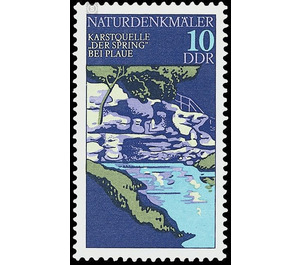natural monuments - Germany / German Democratic Republic 1977 - 10 Pfennig
Theme: Architecture
| Country | Germany / German Democratic Republic |
| Issue Date | 1977 |
| Face Value | 10.00 |
| Color | blue |
| Perforation | K 12 1/2: 13 |
| Printing Type | offset |
| Stamp Type | Postage stamp |
| Item Type | Stamp |
| Chronological Issue Number | 1945 |
| Chronological Chapter | GER-DDR |
| SID | 954418 |
| In 23 Wishlists | |
Natural Monuments The Ministry of Posts and Telecommunications of the German Democratic Republic publishes five multi-colored special postal stamps depicting natural monuments in the GDR. Natural Monuments The development of the developed socialist society also places new and larger tasks on nature conservation. The predominantly preserving aspect for individual objects and areas as a special nature protection task became too narrow. It was a matter of using and protecting the entirety of nature and its riches as planned. Therefore, on May 14, 1970, the new comprehensive Land Culture Act of the GDR was issued, which sets out in its first Implementing Regulation of May 14, 1970 - the Nature Conservation Ordinance - the tasks of special nature conservation. On this basis, about 18 percent of our land area is currently protected as nature reserves (nearly 410 areas with about 18,000 square kilometers), one percent of our land as a nature reserve (about 700 areas with about 90,000 hectares) and about 10,000 objects as natural monuments. The "natural monuments are ... individual entities of nature, which are witnesses of the history of the earth and the landscape, have scientific or homeland significance, or are distinguished by special beauties or their value for education." (in accordance with § 11 of the first implementing regulation). They can have a surface area of up to three hectares and are then referred to as surface nature monuments. Here are five representatives of our Natural Monument complex. The 10 Pfennig value shows the karst spring "Der Spring" near Plaue, district Arnstadt, district Erfurt (under protection by the council of the district Arnstadt on 29th January 1959). Karst springs are among the so-called karst phenomena. They are caused by the effects of groundwater and surface water in soluble rocks. The Spring is with an average fill of 500 l / sec. (in 10 individual sources) the strongest source of Thuringia. The feeding takes place from the sunken river water of the wild Gera as well as the seepage water from the karst area of the plateau of Gossel.


